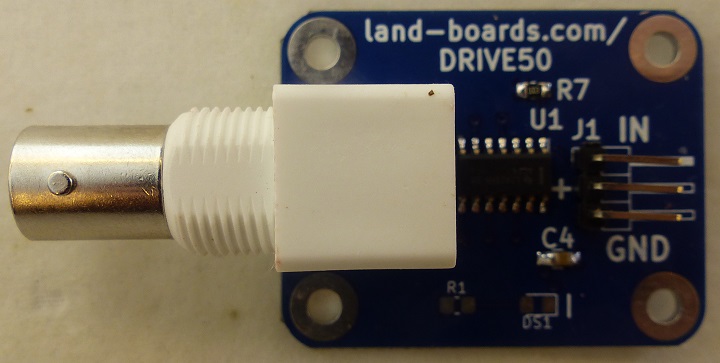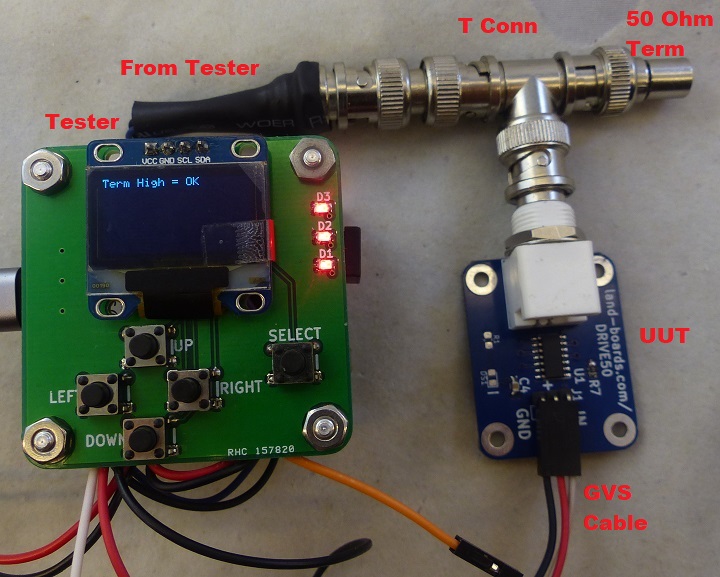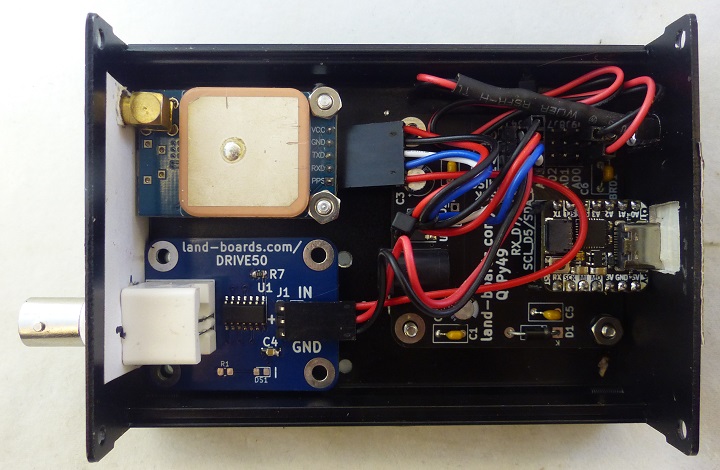Difference between revisions of "DRIVE50"
Jump to navigation
Jump to search
Blwikiadmin (talk | contribs) |
Blwikiadmin (talk | contribs) (→Setup) |
||
| (10 intermediate revisions by the same user not shown) | |||
| Line 21: | Line 21: | ||
*** Symmetric high-low drive levels | *** Symmetric high-low drive levels | ||
** Short-circuit proof | ** Short-circuit proof | ||
| − | *** 5V, 250 Ohms to ground is 20 mA (pins are rated for 24 mA | + | *** 5V, 250 Ohms to ground is 20 mA (pins are rated for 24 mA) |
| − | * Card input | + | *** 0.125 W resistor (5V output through 249 ohm resistor with output shorted to ground is 0.1 W) |
| + | *** 3.3V, 250 Ohms to ground is 13.2 mA (pins are rated for 24 mA) | ||
| + | *** 0.125 W resistor (3.3V output through 249 ohm resistor with output shorted to ground is 0.044 W) | ||
| + | * Card has input buffer stage | ||
* Schmitt Trigger Input | * Schmitt Trigger Input | ||
* 3.3V, 250 Ohm resistors (/5) for 50 Ohm output | * 3.3V, 250 Ohm resistors (/5) for 50 Ohm output | ||
| Line 45: | Line 48: | ||
==== Setup ==== | ==== Setup ==== | ||
| − | * [[QTPy49]] | + | * [[QTPy49]] or [[QTPy49-01]] card |
| − | * [[ | + | * [[QT Py (RP2040_based)]] card |
** Analog cable | ** Analog cable | ||
** GVS Cable to A1 | ** GVS Cable to A1 | ||
** Analog in (BNC) to A0 on [[QTPy49]] | ** Analog in (BNC) to A0 on [[QTPy49]] | ||
| − | * [[MyMenu]] | + | * [[MyMenu]] card |
* Power card options | * Power card options | ||
| − | ** Connect USB-C to the [[ | + | ** Connect USB-C to the [[QT Py (RP2040 based)]] or |
** Power from 9-12V to DC jack | ** Power from 9-12V to DC jack | ||
| − | |||
| − | |||
| − | |||
* Terminator - dependent on build option | * Terminator - dependent on build option | ||
** 50 Ohms | ** 50 Ohms | ||
** 75 Ohms | ** 75 Ohms | ||
* Unit Under Test (UUT) | * Unit Under Test (UUT) | ||
| − | * [https://github.com/land-boards/QT-Py/blob/main/CircuitPython/lbcards/PulseGen/PulseGen_DRIVE50_Test.py PulseGen_DRIVE50_Test.py] | + | * [https://github.com/land-boards/QT-Py/blob/main/CircuitPython/lbcards/PulseGen/PulseGen_DRIVE50_Test.py PulseGen_DRIVE50_Test.py] |
| − | ** Stored as code.py on [[ | + | ** Test software for [[PulseGen]] and DRIVE50 cards |
| − | + | *** Auto-detects card type | |
| + | ** Stored as code.py on [[QT Py (RP2040 based)]] to auto-run | ||
==== Procedure ==== | ==== Procedure ==== | ||
| Line 90: | Line 91: | ||
* [[GPS_Frequency_Standard|GPS Frequency Standard]] | * [[GPS_Frequency_Standard|GPS Frequency Standard]] | ||
| − | * Card drives 50 | + | * Card takes in PPS signal out of GPS module and drives 50 Ohm, 10 MHz Frequency Standard output on coax via BNC connector |
== Mechanicals == | == Mechanicals == | ||
Latest revision as of 11:25, 20 August 2022
Contents
50 Ohm Driver Card
- "TTL" Level Line driver
- 50 or 75 Ohm output impedance
- BNC or SMA output connector
- 10K pull-up on input
- Card is non-inverting
- 1.5V-5.5V power
- Typically 3.3V or 5V
- 3-pin right angle 0.1" pitch input connector
- (4) 4-40 mounting holes
Driver
- 5x paralleled 74AC14 drivers
- 24mA per pin max current output
- Symmetric high-low drive levels
- Short-circuit proof
- 5V, 250 Ohms to ground is 20 mA (pins are rated for 24 mA)
- 0.125 W resistor (5V output through 249 ohm resistor with output shorted to ground is 0.1 W)
- 3.3V, 250 Ohms to ground is 13.2 mA (pins are rated for 24 mA)
- 0.125 W resistor (3.3V output through 249 ohm resistor with output shorted to ground is 0.044 W)
- 24mA per pin max current output
- Card has input buffer stage
- Schmitt Trigger Input
- 3.3V, 250 Ohm resistors (/5) for 50 Ohm output
- Normal output = 10 mA per pin
Test
- Manual or Automated test methods
Manual Test Method
- Supply Vcc 3.3V to 5V and ground
- Input is pulled up to Vcc
- Measure output with BNC T
- Should be 1/2 of Vcc with 50 Ohm terminator
- Should be Vcc without terminator
Automated Test Software Method
Setup
- QTPy49 or QTPy49-01 card
- QT Py (RP2040_based) card
- Analog cable
- GVS Cable to A1
- Analog in (BNC) to A0 on QTPy49
- MyMenu card
- Power card options
- Connect USB-C to the QT Py (RP2040 based) or
- Power from 9-12V to DC jack
- Terminator - dependent on build option
- 50 Ohms
- 75 Ohms
- Unit Under Test (UUT)
- PulseGen_DRIVE50_Test.py
- Test software for PulseGen and DRIVE50 cards
- Auto-detects card type
- Stored as code.py on QT Py (RP2040 based) to auto-run
- Test software for PulseGen and DRIVE50 cards
Procedure
- Connect 3 pin power cable to card
- Connect BNC T to output of card
- Connect BNC female from tester to BNC T male
- Install 50 terminator to other side of BNC T
- Connect USB C cable
- Display will show
PulseGen/DRIVE50 V1.1 50 Ohm card Set/Got Low Term High = OK
- All 3 LEDs are on
Application Example
GPS Frequency Standard
- GPS Frequency Standard
- Card takes in PPS signal out of GPS module and drives 50 Ohm, 10 MHz Frequency Standard output on coax via BNC connector




